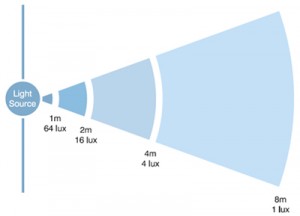Illuminators
Product overview
High-performance white and infra-red LED illuminators for all conditions. Recommended for both indoor and outdoor use.
Vandal-resistant IR illuminators for the outdoor models of the AXIS P33 Series. Recommended for outdoor use.
How it works
The most important aspect in designing any lighting system is achieving even illumination. To achieve the best images at night, the illumination must be evenly distributed, using lighting products designed for this purpose.
Light intensity and distance

As light travels away from a point source, it spreads both horizontally and vertically, with less light at greater distance. The amount of light available at a particular distance is inversely proportional to the square of the distance from the light source. The inverse-square law applies to white light and infrared light in the same way.
Example: An object that is placed at 2 m from a light source receives 16 lux. Moving the object 8 m away from the source, results in it receiving only 1/16 (1/42) of the light, i.e. only 1 lux.
| No. of units |
Distance multiplier |
| 1 | 1 |
| 2 | 1.4 |
| 3 | 1.7 |
| 4 | 2 |
| 5 | 2.2 |
| 6 | 2.4 |
| 7 | 2.6 |
| 8 | 2.8 |
| 9 | 3 |
The inverse-square law explains how the amount of light drops over distance, but it can also be used to calculate how many additional illuminators are needed to achieve specific increases in distance.
Example: If the distance from a single illuminator is doubled, the amount of the light will be reduced to a fourth. Thus in order to keep the same light intensity at the scene at twice the distance, four illuminators will be needed (22 = 4). Similarly, to achieve the same illumination at three times the distance, nine illuminators will be required (32 = 9).
The inverse-square law can also be used for calculating the effect of using multiple illuminators, by taking the square root of the change in available light at source.
Example: Using four illuminators will double the distance (√4 = 2). Using 25 illuminators will result in a 5-fold increase in distance (√25 = 5).
Tips:
- It is not always necessary to use multiple illuminators to increase the covered range. Illuminators with narrower angles or more powerful illuminators will both provide the required additional increase in distance.
- If you need to monitor a particular object at a particular distance, using e.g. a zoom lens, then you can place a small illuminator close to the object. For example when monitoring a gate or door at a site perimeter, relatively far from the site’s buildings and other infrastructure.
- Doubling the distance requires 4 times the illumination power.
- Doubling the number of illuminators provides a 1.4 times increase in distance.
Low light monitoring
When monitoring an area with poor lighting, the noise in the image increases. This results in:
- Higher storage costs
- Higher bandwidth request
- Overloads of the network
To overcome these problems, you can limit the frame rate or increase the compression in the network camera. However, this would result in the following disadvantages:
- Risk of missing some action
- Losing sharpness
- Losing pixel details
- Bad image quality
A better solution would be to combine an Axis network camera and an Axis IR illuminator, as it enhances the camera’s ability to produce high-quality video in lowlight or nighttime conditions:
- B/W images with no noise, i.e. sharper images in B/W compared to color images
- High frame rate, but low bandwidth
Conclusion
Using infra-red illumination in dark indoor installations saves up to 95% bit rate and storage space. In dark outdoor installations, it saves up to 75% bit rate and storage space.

